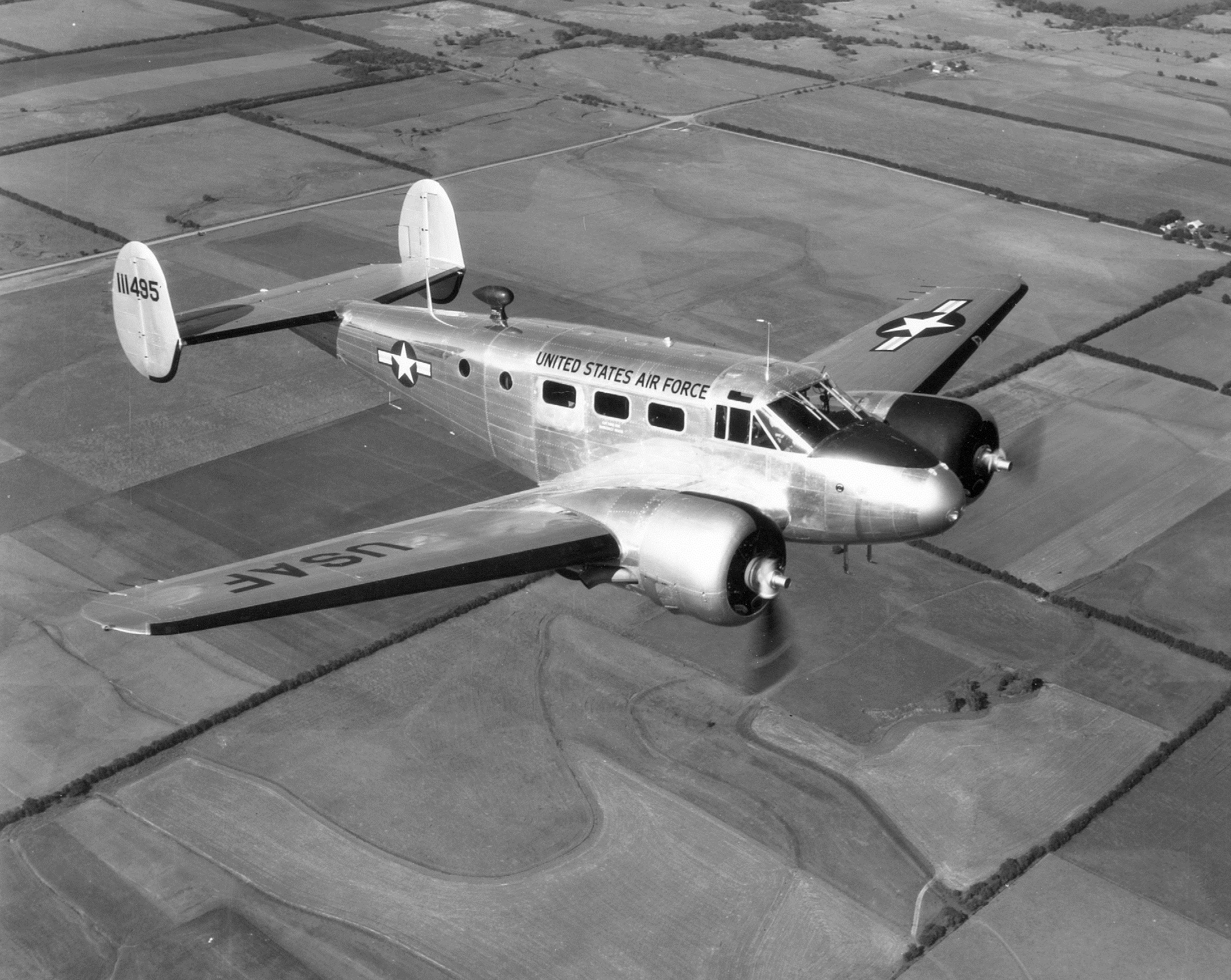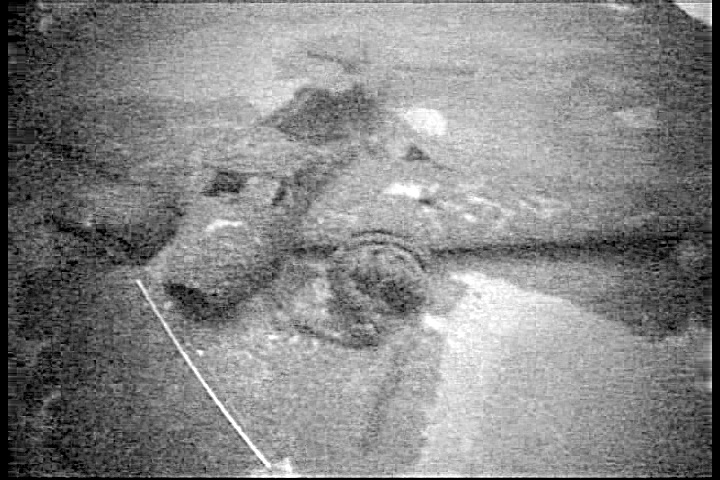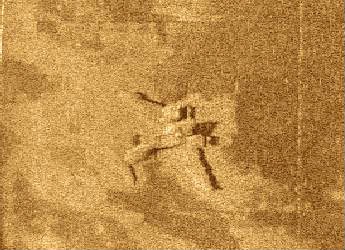
Flying on a routine Training trip, the C-45 Expeditor carrying four passengers and a pilot had a malfunction on the left engine as it started to fail. All passengers and crew of the plane safely parachuted out as the plane continued on and crashed over Lake Ontario near Oswego, NY, in September 11, 1952. The wreck of the plane was discovered at the bottom of the lake mostly intact in 2014 by an exploration team looking for shipwrecks in that area.
The Routine
The C-45 Expeditor was a military aircraft used during WWII. The craft was on a routine training exercise carrying three air force officers and two civilians en route from Bedford, Massachusetts to the Griffiss Air Force Base near Rome, New York. the pilot was Lt. Col. Charles A. Callahan with two military officers, Lt. Sam Sharff and Lt. Col. G. S. Lambert, and 2 civilian passengers, William P. Bethke and Joseph M. Eannario. [7] The civilians on board were technical advisors to observe the training procedure.
The Crash
The plane was almost to its destination. It was approximately 40 miles southeast of Utica, New York, when the left engine of the plane started to fail. The engine was still working but the plane was no longer able to maintain a steady altitude when they were about 8 miles from Rome, New York. [2] The pilot did not think that the plane would be able to land with the engine failing so he ordered all four passengers to parachute out of the plane while they were still at a safe altitude to do so then he followed shortly afterwards. All the passengers landed near Schutler Corners, about 15 to 20 miles southeast of Utica. For all 5 people on board, it was the first time any of them had parachuted. They started to jumped from the plane at an altitude of approximately 2,500 ft. The pilot reported that he jumped out of the plane last at an altitude of approximately 800 ft, around the same height as the nearby radio communication towers. None of the passengers were injured from the jump. [3] Callahan described his parachuting experience as he was “Sweating it out.” [1] He thought that as he was about to jump at 800 ft above the ground that he would not have enough time for his parachute to open. He continued with, “I pulled the ripcord. It seemed to take a long time to come out. I felt a jolt and my head snapped back. Then my feet hit the ground and I rolled over into a barbed wire fence.” [1] The plane, with a lightened load, rose in elevation and was left on a course that the pilot hoped would end in a non populated area. [8] The plane continued to fly with no passengers for about 70 minutes, or about 65 miles, then crashed into Lake Ontario. There were at least two eyewitnesses of the plane crashing. The owner, Rudy Gadzalia, of Rudy’s Refreshments which was a local store near the water, and one of the employees, Jack Mulcahey, saw the plane as it approached Oswego flying very low and witnessed the crash. They saw the plane start to circle over the water as it slowly lost altitude. It is theorized that the plane’s engine had finally fully failed and the circling was caused by the one engine turning the plane in a continuous circle until the crash. Gadzalia and Mulcahey also claimed to have seen a large flash of light that lasted for several seconds as the plane crashed into the lake. [4] This is most likely do to the burn up of the leftover fuel in the plane.
The Recovery

The witnesses claimed the plane had crashed about a mile off of the shore of Oswego. The Coast Guard and United States Air Force searched the area where the crash was reported for two days after the crash. There were three coast guard cutters searching for any sign of the wreckage as well as planes from the Air Force such as C-45’s, C-47’s, and B-25’s. Even with a this large of a search force and a decent knowledge of where the plane had crashed, they were unable to find any wreckage of the plane. After the two days, the search was called off and there was nothing found of the plane for 61 years. [9] On July 27, 2014 an exploration team looking for shipwrecks stumbled upon the plane using sonar imaging. The plane was found much further from the shore than what was reported from the witnesses. [5] [11] This is because of a few possibilities. One possibility being that it can be very difficult to judge distance over water. What looks like one mile could in reality be 3 miles. The plane crashed at 11 pm as well, so visibility was very poor to see how far away the crash actually was. A second possibility is that when the plane hit the water, it did not sink straight down. The wings help the plane glide in the air and they would help the plane glide in the water as well, perhaps not well but it could account for some of the difference of distance between the estimated one mile off shore to the reality of well beyond a mile off the shore. The team, Jim Kennard, Roger Pawlowski, and Roland Stevens, were very surprised to see the wreck of a plane on their sonar screen. They were looking for historic shipwrecks in the eastern end of Lake Ontario. The wrecked plane was found in more than 150 feet deep water even though it was reported to have crash landed in 80 to 100 feet deep water. It was found much further from the shore so the deeper water is appropriate for this discovery. The discovery team able to get better images of the crashed plane by dropping a remote controlled VideoRay Pro IV vehicle into the water and using it to get a video of the plane under the water even in 150 feet deep water. [6] [10] The plane was left almost completely intact after the crash which would explain why there was no trace of wreckage found from the search party directly after the crash. The plane was left almost completely intact from the crash mainly because it landed in the water. The water was able to cushion the impact of the planes crash keeping it in mostly one piece. The plane was missing its nose cone and the vertical stabilizers as well as part of the main body on the left side of the plane. The propeller of the left engine was broken off but it was lying nearby the rest of the plane. The windshield was broken as well but if that was from the initial crash or due to the water pressure is unknown. The entire shape of the plane is easily distinguishable even though it has been covered with underwater organisms. The plane has been recovered and pulled out of the lake. The plane is technically still the property of United States Air Force, but they did not make an immediate comment on the planes discovery. [12]

The Use of the C-45
The C-45 was first flown in the United States on January 15, 1937 and it was produced for 32 years with there still being some active C-45’s today. It was used as a transport vehicle for the United States Air Force as well as a training vehicle. Other departments of the military used the design of the plane as well. Other countries militaries used it as well such as Canadian Air Force and the British Royal Navy. The plane could hold six to nine passengers, depending on the variation of the original design, and had a crew of a pilot and a co-pilot. The plane had a wingspan of 47 feet and 8 inches. The plane was 9 feet 8 inches tall and it was 34 feet 3 inches long. It being a small plane, it only had a range of about 1,200 miles with a cruising speed of about 211 mph and a max speed of about 225 mph. [10] With a range of only 1,200 miles, the plane was used for short hops between military bases mainly for quick and easy transportation. The maximum elevation the plane could reach was about 20,000 feet.
Design of the C-45
The C-45 was made by the Beechcraft Aircraft Corporation. The craft had two Pratt and Whitney R986 AN 1 Wasp Junior 9 cylinder radial air cooled 450 Hp propeller engines on each wing. The wings were attached to the bottom of the plane with a slight upwards tilt to them, like a very shallow V. There were three wheels on the craft with one located under each engine and a single wheel on the tail of the plane. When the plane was resting on level ground, it would have a slight tilt up at the nose compared to the rear of the plane. The top of the plane was mostly flat while the tail sloped upwards at the rear of the plane. The tail of the plane was a H-style tail. This means it has a flat horizontal tailpiece with two vertical smaller fins on either end of the horizontal tailpiece. The had an empty weight of 6,175 pounds and a maximum loaded weight of 8,727 pounds. With 9,388 aircrafts made in production, there are still approximately 250 still operational today.
Models of the C-45
The original model of the C-45 was a civilian model of the airplane, the Model 18 “Twin Beech” series. The plane was added to the United States Air Force as World War II was approaching and the military was expanding due to the tension of the conflict. The Model 18 was incorporated not only into the United States Air Force, but also the United States Navy and the United States Marine Corps. Throughout the military, there were approximately 9,388 Model 18’s that had 32 different versions of of the original design. The C-45 was one of these variants that was used by the United States Air Force. The Model 18 was given a new name for the United States Air Force but its overall design was not changed when its name changed to the C-45. During its production, the C-45 had many different models in the United States Air Force used for different reasons. Mostly the craft and its models were used as transportation. The different models usually only changed the interior for the particular mission or standards that would be needed. The different models could have adaptations for the C-45 to carry different cargo such as photography equipment or MEDEVAC equipment. The model “Expeditor II” was given to the British Royal Navy and the model “Expeditor III” was given to the Canadian Air Force. Eventually every branch of the military had a version of the Model 18 as the aircraft was a well designed piece of machinery.
Map Location
Primary Sources
- “Parachute Jump First For 5 Abandoning Plane Which Fell in Ontario.” The Post-Standard, 12 Sept. 1952 [Syracuse N. Y.] , p. 5.
- “Crew Bails Out Of Crippled Air Force C-45 Plane Crashed In Lake Hour Later.” The Bee, 11 Sept. 1952 [Danville Virginia] , p. 19.
- “CREW BAIL OUT OF PLANE UTICA, N. Y.” The Monroe News-Star, 11 Sept. 1952 [Monroe, Louisiana] , p. 8.
Secondary Sources
- Albrecht, Brian. “Long-lost Air Force plane discovered in Lake Ontario by National Museum of the Great Lakes explorers.” Cleveland.com, 8 July 2014.
- Murphy, Justin. “Six decades after crash, plane found at bottom of lake.” Democrat and Chronicle, USA Today Network, 7 July 2014.
- “Explorers find 1952 US air force plane wreck in Lake Ontario.” The Guardian, 8 July 2014.
- “Shipwreck hunters make rare find on Lake Ontario: Air Force Plane that went down in ’53.” Air Museum Network, Air Museum Network, 14 July 2014.
- “Plane headed to Griffiss found after 61 years.” Rome Sentinel, Rome Sentinel, 8 July 2017.
- “6 decades later, U.S. Air Force plane wreck found in Lake Ontario.” CBS News, CBS News, 8 July 2014.
- Kennard, Jim. “U.S.A.F. aircraft abandoned in flight discovered in Lake Ontario.” Shipwreck World, Shipwreck World, 8 July 2014.
- Moses, Sarah. “U.S. Air Force plane abandoned.” Syracuse.com, Syracuse.com, 8 July 2014.
- “Explorers find 1952 US plane wreck in Lake Ontario.” TheMiddletownPress, The Associated Press, 8 July 2014.
For Further Reading
- “Beechcraft C-45 (Expeditor) Utility / Trainer Aircraft.” Military Factory, 26 Aug. 2017.
- CAF AirPower History Tour, 2013.
- “USAF C45 aircraft abandoned in flight found in Lake Ontario.” YouTube, YouTube, 8 July 2014.
